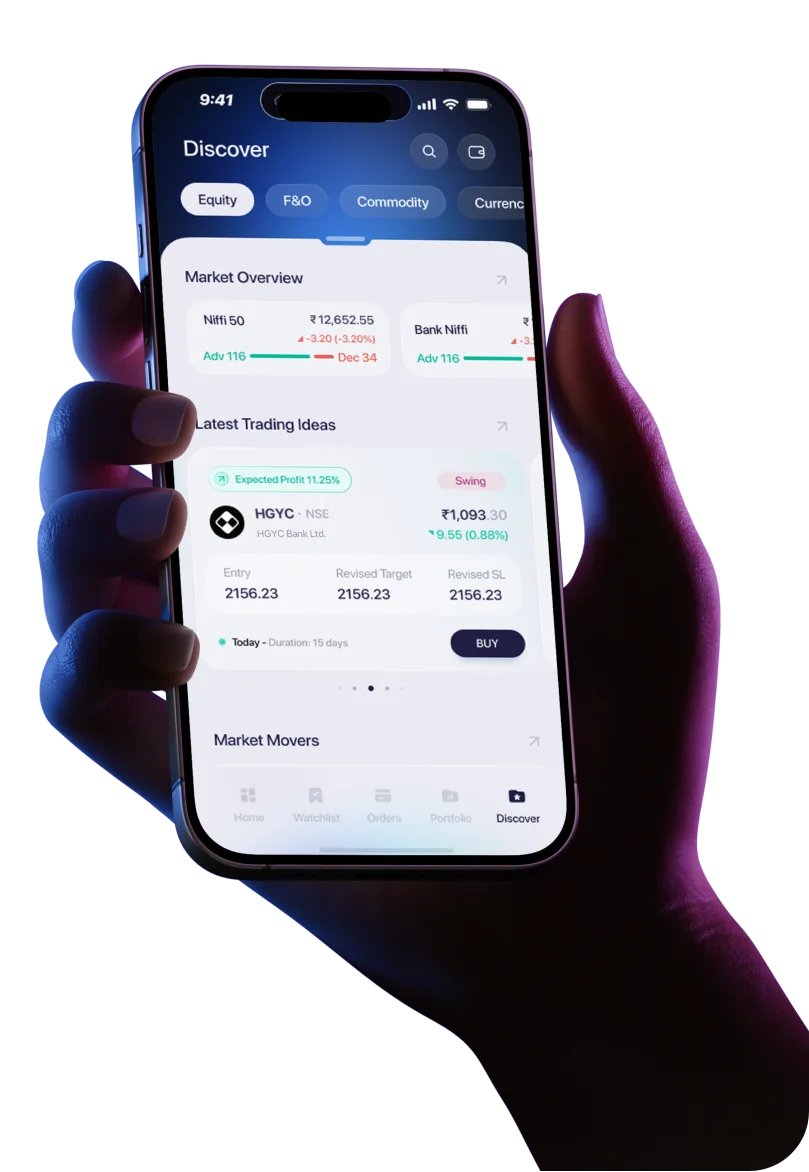In this article
- Understanding Upper Circuit Limits
- Understanding Lower Circuit Limits
- Circuit Filters in Indian Stock Market
- How Circuit Filters Impact Stock Market Trading?
- Advantages of Circuit Limits
- Disadvantages of Circuit Limits
- Best Practices for Trading within Circuit Limits

Stock market trading is essential to global financial systems, with millions of traders and investors buying and selling stocks daily. While stock prices are determined by supply and demand, they can sometimes fluctuate too quickly or drastically, leading to sharp price changes that may impact investor sentiment and market stability. To address this issue, exchanges worldwide have implemented circuit limits, pre-determined price bands that restrict the maximum upward or downward movement of stock prices during a share trading session.
This article will explain the concept of upper and lower circuit limits, their significance in stock market trading, and how they function in various financial markets. We will also discuss the advantages and disadvantages of circuit limits, frequently asked questions, and best practices for trading within circuit limits.
Understanding Upper Circuit Limits
Upper circuit limits are price bands that limit the maximum upward movement of stock prices during a trading session. These restrictions prevent sharp price increases brought on by irrational demand, panicked buying, or other factors. In other words, when a stock price reaches the upper circuit limit, it cannot increase further until the circuit limit is reset or revised.
Typically, the upper circuit limit is specified as a percentage of the stock's closing price from the previous trading day. For instance, if a stock closes at Rs. 100 on a particular day, and the upper circuit limit is set at 10%, the maximum price at which the stock can be traded on the next day would be Rs. 110.
Factors Affecting Upper Circuit Limits
Several factors affect the upper circuit limits. Here are some of them:- Volatility of the stock: The upper circuit limit of a stock may be adjusted based on the volatility of the stock. If the stock is highly volatile, the circuit limit may be set lower to prevent excessive price movements.
- Overall market conditions: Circuit limits may be adjusted based on the overall market conditions. For instance, circuit limits may be lowered during high market volatility or uncertainty to prevent panic selling or buying.
- Trading volumes: If a stock experiences high share trading volumes, the circuit limits may be adjusted to prevent price distortions and ensure fair trading.
- Corporate actions: Corporate actions such as mergers, acquisitions, or bonus issues can impact the stock price. Circuit limits may be adjusted to reflect these changes and prevent excessive price movements.
- Regulatory requirements: Stock exchanges are regulated by authorities such as the Securities and Exchange Board of India (SEBI). These regulatory bodies may prescribe circuit limits for certain stocks or market segments based on their analysis of market conditions and trends.
Examples of Upper Circuit Limits in Action
An example of upper circuit limits in action occurred during the initial public offering (IPO) of Happiest Minds Technologies in September 2020. The stock was listed at Rs. 351 on the National Stock Exchange (NSE), and its upper circuit limit was 20%. As a result, the stock price surged to Rs. 421, and trading was halted due to the upper circuit limit being reached. The circuit limit was revised to 10%, allowing the stock to continue trading within that range.
Understanding Lower Circuit Limits
Lower circuit limits are the opposite of upper circuit limits. They are the price levels below a stock's share trading is halted for the day. When a stock hits its lower circuit limit, trading is suspended, and investors cannot place sell orders at lower prices. Lower circuit limits are designed to prevent the stock price from falling too quickly and protect investors from significant losses.
-
What is a Lower Circuit?
When a stock falls to its lower circuit limit, the price has hit the maximum permissible downward movement for the day. Trading is suspended, and investors can only place buy orders for the stock at or above the lower circuit limit. The lower circuit limit is calculated as a percentage of the stock's previous day's closing price and is fixed by the stock exchange.
-
Factors Affecting Lower Circuit Limits
- The volatility of the stock: If a stock is highly volatile, its lower circuit limit may be adjusted to prevent excessive price movements.
- Market conditions: The overall market conditions can impact lower circuit limits. In times of high market volatility or uncertainty, circuit limits may be set lower to prevent panic selling.
- Trading volumes: High trading volumes in stock can cause price distortions, and lower circuit limits may be set to ensure fair practices.
- Corporate actions: Corporate actions such as mergers, acquisitions, or bonus issues can impact the stock price. Lower circuit limits may be adjusted to reflect these changes and prevent excessive price movements.
- Regulatory requirements: Regulatory bodies such as the SEBI may prescribe lower circuit limits for certain stocks or market segments based on their analysis of market conditions and trends.
-
Examples of Lower Circuit Limits in Action
Lower circuit limits are commonly seen during market volatility or when a company reports poor earnings. For instance, in March 2020, amid the COVID-19 pandemic, several stocks hit their lower circuit limits as the Indian stock market crashed. Similarly, in May 2020, when Yes Bank reported poor earnings, its stock price hit its lower circuit limit, and trading was halted.
Circuit Filters in Indian Stock Market
Circuit filters are trading regulations that aim to prevent extreme price volatility in the stock market. In India, the Securities and Exchange Board of India (SEBI) is the regulatory body responsible for implementing circuit filters.
-
Explanation of SEBI's Role in Implementing Circuit Filters
SEBI's circuit filter regulations mandate that stock exchanges implement price and volume-based circuit filters for individual securities. These filters are designed to automatically halt share trading if the price or volume of a security exceeds a specified threshold.
-
Types of Circuit Filters
How Circuit Filters Impact Stock Market Trading?
Circuit filters have a significant impact on stock market trading. While they can help to prevent market crashes and price manipulation, they can also limit liquidity, increase volatility, and affect investor sentiment.- Liquidity: Circuit filters can limit liquidity by restricting share trading activity when prices or volumes exceed a certain threshold. This can make it difficult for traders to buy or sell securities at their desired prices.
- Volatility: Circuit filters can also increase volatility by limiting trading activity and creating a backlog of orders. When trading resumes after a circuit breaker, there can be a sudden influx of orders, leading to a rapid price increase or decrease.
- Investor Sentiment: Circuit filters can affect investor sentiment by creating a sense of uncertainty and panic. When trading is halted, investors may become anxious about the reason for the circuit breaker, leading to a sell-off once trading resumes.
Advantages of Circuit Limits
- Limits market volatility: Circuit limits help to limit extreme price movements of a stock by halting trading when the stock price reaches the circuit limit.
- Increases liquidity: Circuit limits improve liquidity in the market by reducing the impact of large and sudden trades on the price of a stock.
- Provides a level playing field: Circuit limits ensure that all market participants have equal opportunities to buy and sell stocks regardless of their size.
- Prevents manipulation: Circuit limits help prevent market manipulation by limiting the ability of a few large traders or investors to influence stock prices.
- Increases investor confidence: Circuit limits provide a sense of security to investors by reducing the risk of extreme price movements and market manipulation.
Disadvantages of Circuit Limits
- Can lead to market inefficiencies: Circuit limits can cause market inefficiencies by limiting the ability of buyers and sellers to trade stocks freely.
- Can result in reduced trading volumes: Circuit limits can reduce share trading volumes in the market by limiting the ability of traders to take advantage of price movements.
- Can create market uncertainty: Circuit limits can create market uncertainty by creating an artificial barrier to trading and limiting price discovery.
- Can lead to delayed trading: Circuit limits can delay trading by halting it altogether or by causing trading to resume only after a certain period.
- May not be effective in extreme market conditions: Circuit limits may not be effective in extremely volatile market conditions, as they may be triggered too often or too late to prevent significant price movements.
Best Practices for Trading within Circuit Limits
Trading within circuit limits can present unique challenges for investors, but some strategies can help manage risk and maximize returns.Tips for Trading within Circuit Limits
- Do your research: Understanding the fundamental and technical factors affecting a stock's performance can help you make informed trading decisions within circuit limits.
- Monitor news and events: Keep track of company news, industry developments, and macroeconomic events that can impact stock prices and circuit limits.
- Set realistic targets: When trading within circuit limits, it is important to set realistic targets for profit and risk management, given the restricted price movements.
- Use limit orders: Placing limit orders can help you buy or sell at a specific price within circuit limits, helping you avoid losses due to sudden price movements.
- Keep an eye on trading volumes: High trading volumes within circuit limits can indicate a trend or direction, which can be useful in trading decisions.
Strategies for Managing Risk and Maximizing Returns in Circuit-Limited Markets
- Diversify your portfolio: Investing in a diversified portfolio of stocks can help reduce risk in circuit-limited markets.
- Use stop-loss orders: Setting stop-loss orders can help limit losses in circuit-limited markets by automatically selling when a specific price is reached.
- Be patient: Circuit limits can lead to increased volatility and unpredictability in the market, but patience can pay off in the long run.
- Keep emotions in check: Circuit limits can be frustrating, leading to impulsive decisions. Keeping emotions in check and sticking to your trading plan is important.
- Use professional guidance: Consider working with a professional financial advisor or a trading app like SAMCO to get expert guidance on trading within circuit limits.
Conclusion
Understanding circuit limits is an important aspect of stock market trading, especially in the Indian market, where SEBI has implemented circuit filters to ensure market stability. Upper and lower circuit limits significantly impact the market's liquidity, volatility, and investor sentiment. While there are advantages and disadvantages to using circuit limits, they remain a crucial tool for managing risk and minimizing losses in volatile market conditions.
To implement these strategies effectively, using a reliable and user-friendly share trading app like SAMCO is important. With its advanced trading tools and features, SAMCO can help investors make informed decisions and maximize their returns within circuit-limited markets. By adopting best practices for trading within circuit limits and leveraging the capabilities of a trusted trading app like SAMCO, investors can achieve their investment goals and build long-term wealth.
So, if you want to take advantage of circuit limits and succeed in the stock market, sign up for SAMCO today and start trading confidently!



 Easy & quick
Easy & quick
Leave A Comment?